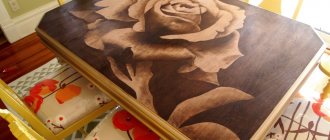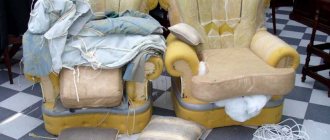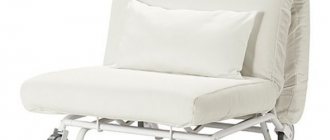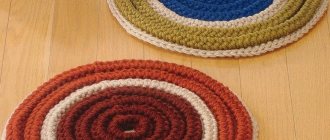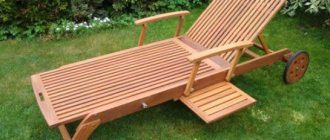I'm a woodworker and love to give old things a second chance. We recently brought back an old chair from the dacha, which was clearly worth showing off in our living room. True, for this it needed to be completely updated and restored. We did it with our own hands quickly and simply; anyone can repeat this “feat” with their own used furniture using our instructions.
Materials and tools:
- stapler and staples;
- sharp scissors;
- 3 cm wood screws;
- 5 cm wood screws;
- high density foam rubber;
- cotton or polyethylene batting;
- elastic upholstery;
- 3 meters of upholstery fabric;
- a large piece of cardboard;
- cardboard potholder;
- 2 metal strips for fastening;
- hammer or mallet;
- upholstery nails;
- cambric fabric (black lining);
- 4 finished legs;
- 4 mounting plates for legs.
Chair restoration ideas: from classic to modern
The theater begins, as has been said many times, with a coat rack, and an apartment and a house begin with a chair. Yes, exactly from him.
The most popular idea for restoring this piece of furniture is the Country or Provence style because they fit into any interior:
Provence style chair
Country style chair
If you want a more sophisticated option, then choose the classic (shown in the photo).
Art Nouveau lovers can “play” from the basic form to the one that comes to your mind.
The simplest options for restoration of wooden chairs are Provence and Country. We advise you to start with them. Another option for restored chairs:
Here's an interesting idea to restore old wooden chairs and make a stand out of them for feeding your pet:
And, finally, an original option for using an old chair near the house or in the country:
Happy restoration!
Features of updating an old chair
Updating furniture involves restoring its appearance and functionality, so you will need to purchase the right tools, replacement parts and upholstery fabric. There are a number of features that you should pay attention to before starting work.
The restoration process may require various materials and tools.
- Tools. In addition to the standard set of tools, to repair a chair you may need a chisel, a grinding machine, a stapler and a screwdriver.
- Materials. For painting with a set of brushes, roller, varnish. This is necessary to restore wooden elements. To dye fabric, purchase universal fabric dye or acrylic paint.
- Details. You may need rollers, a crosspiece to secure them, as well as new springs and bolts.
- Upholstery fabric. The material for the cladding is chosen to be high-quality and wear-resistant. These types include velor, chenille, jacquard, tapestry, eco or genuine leather. Krylon is used for interior upholstery. Ordinary foam rubber can be used as a filler.
Tools and materials that you may need when carrying out restoration work on chairs.
Important! It is better to entrust the restoration of antique furniture and mahogany chairs to specialists, since in this case it will be necessary to restore historical authenticity. This may require special finishing, gilding, painting, patination and other processes that are difficult to perform at home.
Today there is a variety of furniture fabrics for upholstering chairs.
How to do a complete cleaning of a chair
To preserve the beauty and newness of furniture, it is important to care for it correctly and in a timely manner. In most cases, these are standard procedures: removing dust and debris with a vacuum cleaner or wet cleaning using special chemicals.
Complete cleaning of the chair is the beginning of restoration.
The choice of method largely depends on the quality of the upholstery material:
- Microfiber. The scolding is carried out using a brush or sponge moistened with a soap solution or detergent without chlorine.
- Velours. This is a decalite material that can only be vacuumed. To remove stains, use water-based products, in small quantities or diluted. You can fluff up the pile and update the appearance with a velor brush.
- Flock and chenille do not tolerate excessive moisture - the structure of the fabric is destroyed when wet. Clean using dry methods.
- Leather products are cleaned with soapy water. After drying, treat with leather polish.
An old chair with torn upholstery can be turned into a chic, exclusive piece of furniture.
When cleaning the chair, pay special attention to the joints, bends and base of the backrest. If possible, remove pillows and armrests and treat the area under them. The wheels are also regularly cleaned - they can become clogged with dust and stop functioning.
The finished chair after reupholstery with your own hands.
Advantages and disadvantages
Hand-made reupholstery of home and office furniture has many advantages:
- significant budget savings - it’s easier to buy a couple of meters of textiles and a piece of foam rubber than a whole new chair;
- creative process - independently remaking even the simplest, nondescript chair will help you feel like a real master;
- the possibility of updating the interior - a freshly redesigned chair will be designed exactly as its owner intended;
- A quality restored product will last for many years.
There are also several negative points:
- the product will be very different from the store one - this matters if you want to create a specific model, but the skills are not yet enough;
- the labor-intensive process - if the chair is badly damaged, not only the fabric is replaced, but also the “filling” - foam rubber, springs, while completely disassembling it;
- For work you will need some tools that are not available in every home;
- You will need to organize a workspace, which will then have to be thoroughly cleaned, since the restoration process is quite dusty.
Types of array
The main property of solid wood is that it consists entirely of wood and does not have any synthetic impurities. Naturally, this characteristic affects the quality of the product. Furniture items made from solid wood are highly durable, and also add a touch of elegance and high aesthetics to even the simplest interior.
The durability of such chairs is associated with the characteristics of the wood structure and its chemical properties.
Due to the fact that solid wood retains sufficient elasticity when maintaining a certain temperature, during the manufacturing process the product can be given absolutely any shape. In addition, furniture made using this technique retains good thermal conductivity for a long time, which is an important quality for armchairs.
Solid wood products (especially handmade ones) are versatile and can fit into any design project. All thanks to unique natural patterns. Now the furniture market is overflowing with cheaper options of the so-called “laminated solid wood”. But it is not difficult to distinguish such a product from a high-quality solid wood chair - the latter have patterns on the surface with a gradual color transition. It happens that when creating a more economical version of a chair, designers use two types of array.
Choosing fabric for upholstery
When choosing a material for upholstering an old chair, you need to take into account the basic requirements for the fabric:
- strength;
- density;
- practicality and cleanability (it is desirable that the fabric has a water-repellent impregnation).
To ensure that a restored chair retains its attractive appearance for a long time, when choosing the right material, the conditions in which the furniture will be used are also taken into account:
- If pets live in the apartment, it is recommended to use flock for upholstery - this wear-resistant material is not covered with snags.
- Chenille or matting are suitable for a chair in a children's room. Dense and pleasant to the touch fabrics are easy to clean and abrasion resistant.
- In the living room, furniture covered with jacquard, leather, tapestry or nubuck will look impressive.
- In a house where people smoke, it is best to buy chenille for upholstery - it does not absorb odors.
Tapestry
Leather
Jacquard
Nubuck
Gozhka
Flock
Chenille
Where can I put a chair
The times when a chair was placed exclusively under a wall or next to a sofa are long gone. Nowadays, non-standard solutions are in trend both in the choice of upholstery and decor, and in the location of its installation. At the same time, the layout of the room is taken into account; depending on it, circular placement, symmetrical or asymmetrical, can be used.
The chair can be placed at the coffee table, near the fireplace, bookcase or near the TV. The main thing is to determine the central element and plan the furniture arrangement from there.
How to remake an old chair with your own hands
The process of restoring a chair is quite labor-intensive and includes several stages. To begin with, the scope of work is determined. The volume depends on the type of product, the degree of wear and the presence of breakdowns. Let's look at how to remake a standard chair with your own hands, in simple and affordable ways.
Reupholstering furniture with your own hands is a labor-intensive, long process that requires a wealth of experience and skills.
Repainting the upholstery
This is the easiest way to refresh your furniture. In this case, the old material does not need to be replaced; to restore it, you will need to purchase a primer, paint in a can or can, primer and brushes.
The process takes place in several stages:
- The chair is wiped and cleaned of dust, removable cushions (if any) are disconnected. Wooden surfaces are protected with masking tape.
- Saturate the surface of the upholstery with water and prime.
- Dilute a small amount of paint with water (in a 1:1 ratio) and apply to a damp cloth. This is important to do to saturate thick layers of fabric. Allow to dry.
- The second layer is applied with undiluted paint, carefully treating all areas.
Even a leather chair can be restored.
After drying, check the quality of the paint. If there are clearings or spots, apply another layer.
Chair reupholstery
Reupholstering furniture is a more difficult and time-consuming process, but in this case you can radically remake the chair. To begin with, choose and buy material and filler, and you should also ensure that you have the necessary tools.
Many people simply throw away old furniture, not realizing that they can restore it with their own hands.
Nails, a screwdriver, a hammer and a stapler must be available. To begin with, they disassemble the structure, remove the armrests and the bottom.
Disassemble the chair completely for high-quality restoration.
Then proceed as follows:
- Carefully remove the old upholstery from all parts of the chair, as it will serve as a template for cutting out new elements.
- The filler is dismantled, also maintaining its integrity.
- They cut out the upholstery elements on new fabric: fit the parts of the back, seat and armrests, and cut out the parts to size, taking into account an allowance of a few centimeters.
- Cut-out foam rubber is placed in the structure and the internal upholstery is attached to the frame using a stapler or nails.
- Lay the fabric on the surface, level it and fix it with a stapler.
Find out what the chair consists of.
Note! You should start attaching the fabric from the middle to avoid distortions and folds. After this, you need to secure the material in the corners, and only after making sure that it is evenly distributed, continue to fasten with staples.
Complete renovation
A complete repair of a chair involves a full range of work, so this is not always easy to do. It all depends on the design features of the product. The office version and the shell chair are more difficult to repair, but a regular wooden model is much easier.
You have some hard work ahead of you to restore the chair.
First, the structure is disassembled and the parts that need repair or replacement are identified. In particular, the following repairs may be necessary:
- Inspect for cracks and chips. They are glued with glue and fixed with staples.
- Strengthen the frame with metal corners.
- In case of significant damage, it is recommended to replace the elements with new ones.
- Loose parts are strengthened by tightening the bolts tightly.
Furniture restoration means restoring not only its functionality, but also its appearance.
To recreate tarnished wooden surfaces you will need: sandpaper, scraper, varnish and stain. Each part is sanded, polished and dust removed. Then apply nitro varnish and allow to dry. Afterwards they are sanded with fine-grained sandpaper. Finally, cover the surface with stain and apply varnish.
Decor feature
For those who are not ready to engage in the labor-intensive process of reupholstering a chair, there are easier ways to improve its appearance. Also, with the help of simple manipulations, you can further protect the updated furniture and add zest to the interior.
New life for an old but beloved chair with your own hands
We offer three options for chair decor:
- A chair cover will look stylish and unusual. You can sew it yourself or order a finished product.
- Decoration with textiles. In this case, you can protect and decorate the seat with a pillow or blanket, which should be in harmony with other accessories.
- The easiest way is to purchase a bedspread. The coating will hide the imperfections of the old upholstery, protect the new one and transform the interior of the room.
You can decorate the chair with a pillow.
Capes and textiles are chosen in accordance with the color scheme of the wallpaper or to match individual decorative elements: in accordance with the color of curtains or carpeting.
Master classes on upholstery of chairs
So, how to reupholster a chair step by step with your own hands is a rather problematic task; it is important to take into account all the manipulations described above. At the same time, there are several secrets that will help you perform the job at the highest level. Here are some of them:
- If the chair has legs, you must first cover the end part and the rear lower crossbar with a rag. Only then is the leg fixed. In this case, you will need to carefully drill a hole in the fabric. Do not leave the leg holes loose when upholstering, as the fabric here will gradually stretch and tear.
- If the armrests are soft, it is better to do the upholstery in the following sequence: first the back, then the seat and only then the armrests. The elements are attached to the frame in the same sequence. In this case, it will be possible to avoid distortions or so-called “bubbles” on the foam rubber. The work will look clean and high quality.
You will receive a beautiful chair at no extra cost.
Remember that these tips will help you upholster your upholstered furniture, not just your chair. If everything is implemented correctly, the result will be such that it will be impossible to distinguish it from the factory one.
Types of array
The most affordable material for making wooden chairs is considered to be coniferous wood. Most often, pine or cedar is used; larch is used less frequently, since solid wood has a high price.
The middle price category is occupied by chairs made of walnut, acacia or ordinary birch. Professionals do not use soft wood, such as linden, for loaded products. Apart from the exotic, such as wenge wood, the elite sector includes oak and beech chairs; a special place here is occupied by furniture made of Karelian birch.
Unique strength and dark, noble tint make walnut furniture highly popular.

